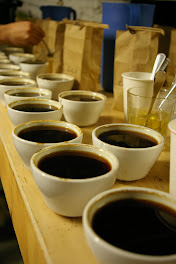Spent a few minutes at the Jack London Square farmer's market today in Oakland, and came across a Pachamama coffee stand. They were offering pour-overs of their Guatemalan single origin coffee. Pachamama is a co-op owned by more than 150,000 coffee farmers around the world.
In the cup, I got a light, woody flavor, currants, and softer, sweeter fruits. You could taste a touch of the roast, but it was really just a hint, it didn't obscure the complexity of the coffee at all.
Thaleon Tremain, who's the company's general manager, was working the stand. I asked him how they roast their coffees; he called it "medium" and said they stop typically before the second crack. "You won't find oils on our beans," he said. When you roast green coffee beans, the first crack is a loud pop you hear that indicates the beans have opened up down the center, and some of the oils inside the bean start to appear on the surface. You can start to think about ending the roast at this point. Later, a second crack is heard, and again, it means more of the bean's oils are escaping. I prefer coffees roasted beyond the first crack but not to the second crack. Once you get to the second crack, you're at what's referred to as a Vienna roast, which is lighter than a French roast, but still pretty dark, in my mind. When coffee is roasted past the second crack, you really lose a lot of the natural exotic flavors in the bean, i.e., the fruity and floral components, while gaining more of caramel, wood, and char flavor.
If you go to a supermarket, and look in those plastic bins of beans, you'll see a silo of dark, sticky beans coated in oil. Roasting that deep deprives the beans of the more subtle flavors you might find in lighter roasted beans. Anytime you see sticky, black beans, run far, far away and don't stop until you see a honeyed, caramel color pile of beans.
Sunday, August 31, 2008
Subscribe to:
Post Comments (Atom)









No comments:
Post a Comment